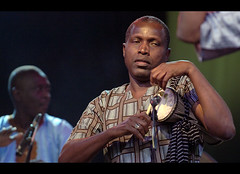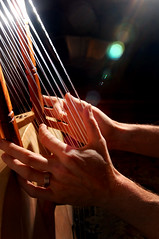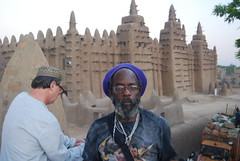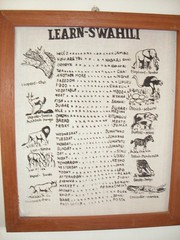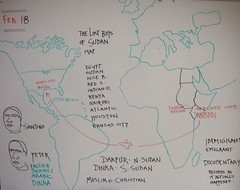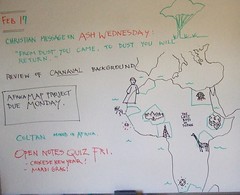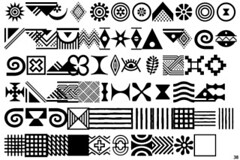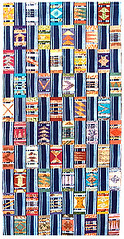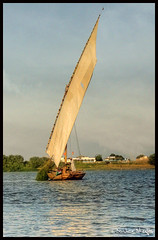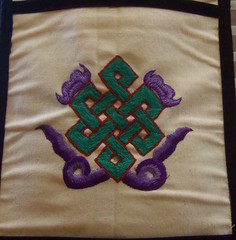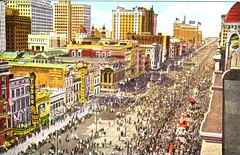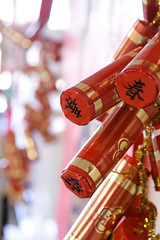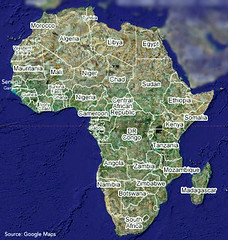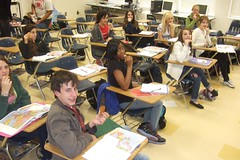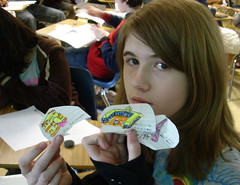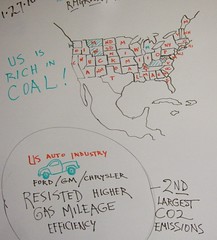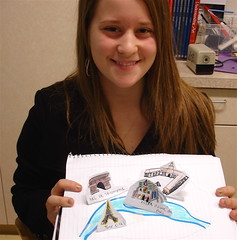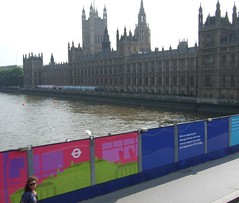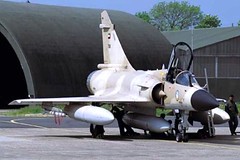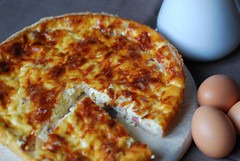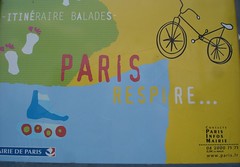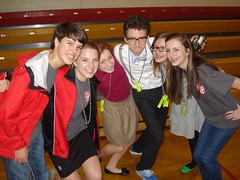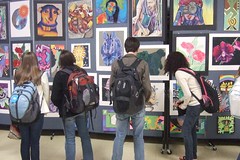The talking drum is a West African drum whose pitch can be regulated to the extent that it is said the drum "talks".
Talking drums are some of the oldest instruments used by west African griots and their history can be traced back to ancient Ghana Empiretimes. The Hausa people (and by influence, the Yoruba people of south western Nigeria and Benin and the Dagomba of northern Ghana) have developed a highly sophisticated genre of griot music centering on the talking drum.
Friday, February 26, 2010
An Elegant Portrait: A Senegalese Chief with his "Griot" (c.1904)
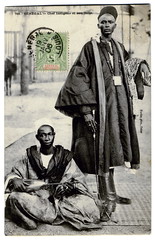
An Elegant Portrait: A Senegalese Chief with his "Griot" (c.1904)
Originally uploaded by postaletrice
According to Paul Oliver in his book Savannah Syncopators, "Though [the griot] has to know many traditional songs without error, he must also have the ability to extemporize on current events, chance incidents and the passing scene. His wit can be devastating and his knowledge of local history formidable."
Although they are popularly known as 'praise singers', griots may also use their vocal expertise for gossip, satire, or political comment.
Kora: the 21-stringed West African harp
A kora is built from a large calabash cut in half and covered with cow skin to make a resonator, and has a notched bridge like a lute or guitar, says Wikipedia.
The sound of a kora resembles that of a harp, though when played in the traditional style, it bears a closer resemblance to flamenco and delta blues guitar techniques. The player uses only the thumb and index finger of both hands to pluck the strings in polyrhythmic patterns (using the remaining fingers to secure the instrument by holding the hand posts on either side of the strings).
Kora players have traditionally come from griot families (also from the Mandinka tribes) who are traditional historians, genealogists and storytellers who pass their skills on to their descendants.
The sound of a kora resembles that of a harp, though when played in the traditional style, it bears a closer resemblance to flamenco and delta blues guitar techniques. The player uses only the thumb and index finger of both hands to pluck the strings in polyrhythmic patterns (using the remaining fingers to secure the instrument by holding the hand posts on either side of the strings).
Kora players have traditionally come from griot families (also from the Mandinka tribes) who are traditional historians, genealogists and storytellers who pass their skills on to their descendants.
The Great Mosque of Djenné, Mali
The Great Mosque of Djenné is the largest mud brick or adobe building in the world and is considered by many architects to be the greatest achievement of the Sudano-Sahelian architectural style, albeit with definite Islamic influences. The mosque is located in the city of Djenné, Mali, says Wikipedia, on the flood plain of the Bani River. The first mosque on the site was built around the 13th century, but the current structure dates from 1907. As well as being the centre of the community of Djenné, it is one of the most famous landmarks in Africa.
Wednesday, February 24, 2010
Somali singer K'naan writes songs from a Swahili-Arabic-African background
From K'naan's song, "Fatima," I learned the Swahili-Arabic words "upendo," which means "love," and "habibi," which means "sweetheart."
K'naan, born Keinan Abdi Warsame in 1978,[2] is a Somali-Canadian poet, rapper and musician, says Wikipedia.
Born in Mogadishu, Somalia,[3] K'naan spent his childhood in Mogadishu[4] and lived there during the Somali Civil War, which began in 1991. His aunt, Magool, was one of Somalia's most famous singers. K'naan's grandfather, Haji Mohamed, was a poet. K'naan is a Muslim. His name, K'naan, means "traveller" in the Somali language.
His family moved to the Toronto, Ontario neighbourhood of Rexdale, where there was a large Somali Canadian community.[5] His family still lives there. In his new country, K'naan began learning English, some through hip hop albums by artists like Nas and Rakim. Despite speaking no English, the young K'naan taught himself hip hop and rap diction, copying the lyrics and style phonetically.
K'naan toured with Jason Mraz during the summer of 2009 for Mraz's Gratitude Cafe Tour. He is currently on tour with Lenny Kravitz on the LLR tour.
A remixed version of K'naan's single "Wavin' Flag" has been chosen as the Coca-Cola anthem for the 2010 FIFA World Cup, to be held in South Africa.[15]
Recordings -
# 2005: The Dusty Foot Philosopher (BMG Music)
# 2007: The Dusty Foot on the Road (Wrasse Records)
# 2009: Troubadour (A&M/Octone)
K'naan, born Keinan Abdi Warsame in 1978,[2] is a Somali-Canadian poet, rapper and musician, says Wikipedia.
Born in Mogadishu, Somalia,[3] K'naan spent his childhood in Mogadishu[4] and lived there during the Somali Civil War, which began in 1991. His aunt, Magool, was one of Somalia's most famous singers. K'naan's grandfather, Haji Mohamed, was a poet. K'naan is a Muslim. His name, K'naan, means "traveller" in the Somali language.
His family moved to the Toronto, Ontario neighbourhood of Rexdale, where there was a large Somali Canadian community.[5] His family still lives there. In his new country, K'naan began learning English, some through hip hop albums by artists like Nas and Rakim. Despite speaking no English, the young K'naan taught himself hip hop and rap diction, copying the lyrics and style phonetically.
K'naan toured with Jason Mraz during the summer of 2009 for Mraz's Gratitude Cafe Tour. He is currently on tour with Lenny Kravitz on the LLR tour.
A remixed version of K'naan's single "Wavin' Flag" has been chosen as the Coca-Cola anthem for the 2010 FIFA World Cup, to be held in South Africa.[15]
Recordings -
# 2005: The Dusty Foot Philosopher (BMG Music)
# 2007: The Dusty Foot on the Road (Wrasse Records)
# 2009: Troubadour (A&M/Octone)
Zanzibar: the culture and language is Swahili
The National Geographic film being aired in class is The Leopards of Zanzibar (National Geographic). The language: Swahili.
Basic Swahili from Kenyatravelideas.com:
Hello - Jambo
Welcome - Karibu
Goodbye - Kwaheri
Yes - Ndiyo
No - Siyo/Hapana
OK - Sawa sawa
Please - Tafadhali
Thank you - Asante
Sorry - Pole
Excuse me - Samahani
No problem - Hakuna matata
What is your name? - Jina lakonani?
My name is ____ - Jina langu ni ___
What's the news? - Habari gani?
Very good - Nzuri sana
Where are the toilets? - Wapi choo?
I don't know - Sijui
I don't understand - Sielewi
Do you speak English? - Una sema KiIngereza?
I speak very little Swahili - Ninasema KiSwahili kidogo sana
Sleep well - Lala salama
Numbers:
zero - sifuri
one - moja
two - mbili
three - tatu
four - nne
five - tano
six - sita
seven - saba
eight - nane
nine - tisa
ten - kumi
Basic Swahili from Kenyatravelideas.com:
Hello - Jambo
Welcome - Karibu
Goodbye - Kwaheri
Yes - Ndiyo
No - Siyo/Hapana
OK - Sawa sawa
Please - Tafadhali
Thank you - Asante
Sorry - Pole
Excuse me - Samahani
No problem - Hakuna matata
What is your name? - Jina lakonani?
My name is ____ - Jina langu ni ___
What's the news? - Habari gani?
Very good - Nzuri sana
Where are the toilets? - Wapi choo?
I don't know - Sijui
I don't understand - Sielewi
Do you speak English? - Una sema KiIngereza?
I speak very little Swahili - Ninasema KiSwahili kidogo sana
Sleep well - Lala salama
Numbers:
zero - sifuri
one - moja
two - mbili
three - tatu
four - nne
five - tano
six - sita
seven - saba
eight - nane
nine - tisa
ten - kumi
Tuesday, February 23, 2010
Lost Boys of Sudan movie: answers to the FAQ's
Santino Majok Chuor has left the factory night shift and Texas and relocated to San Jose, CA. He has enrolled full-time in community college with a generous scholarship from one of the film's viewers. Santino has traveled a great deal with the film participating in media interviews, school screenings and panel discussions in New York, Los Angeles, San Francisco, Indianapolis and Dallas.
Peter Nyarol Dut graduated from Olathe East High School in June of 2003. He is currently a student at Green Mountain College in Vermont with a full scholarship. Along with his studies, Peter is happily playing basketball again. Since the film’s release Peter has participated in meetings with the Congressional Refugee and Human Rights Caucuses, the State Department’s Bureau of Population, Migration and Refugees, the Kansas State Board of Education and CARE.
Megan Mylan & Jon Schenk: We saw the film as a way to tell the story of an underreported civil war in Sudan, an important international story. But we also felt like through the eyes of these young men coming to our country, it would be a unique way to look at ourselves and reveal this crazy modern world we’ve created in the U.S. The newcomer story is so central to who we are as a country.
The 10 agencies that are officially subcontracted by the U.S. government’s Refugee Program to resettle refugees are to provide basic services to newly arrived refugees such as airport reception, housing for at least one month, household goods and clothing, assistance with applications for medical and cash assistance, referrals to English language courses and job placement services. Their initial period of providing assistance is 90-days, though many agencies work with their refugee clients for much longer and offer many more programs, but the goal is to make refugees self-sufficient. The agencies work with very small staff and tight budgets, receiving only a portion of their funding from the federal government.
We were looking for youth whose English level was strong so that they would be more likely to interact with Americans, but most importantly we were looking for strong, interesting individuals. And we found that in Peter Dut and Santino Chuor. Peter and Santino stood out to us from the beginning. Peter impressed us with his energy, practicality and focus, Santino with his warmth and sensitivity. They struck us as two very distinct individuals who would approach life in America differently. They also seemed like two people we would enjoy spending the next year of our life with, and they were.
In Sudan an individual birth date is not given the same importance in their culture as it is in the U.S. Additionally, birth records were not kept in most of the villages where the boys were born. Since many of the youth lost their parents when they were very young, they didn’t have anyone to keep track of their birthdate. When the group arrived at the UN refugee camps, they were assigned ages, the aid workers made their best guess at the youth’s ages and assigned them all the birthdate of January 1st, with whatever corresponding year seemed appropriate.
The most challenging part of making Lost Boys of Sudan, beyond the usual filmmaking struggles of fundraising, permissions and distribution, was not being able to be the friends that Peter and Santino so desperately needed. As filmmakers trying to give an honest portrayal of the struggle to start life in a new, strange country, we had to keep a certain degree of distance from and intervene in their lives as little as possible. It wasn’t an easy thing to do. It was so tempting to just help the guys find good jobs, sign up for community college and make new friends and discuss with them the breadth of who we are as a country. We knew if we did that, we would make life for Peter and Santino better, but not come away with a film that could help people all across the U.S. understand the challenges of being a newcomer to America.
Peter Nyarol Dut graduated from Olathe East High School in June of 2003. He is currently a student at Green Mountain College in Vermont with a full scholarship. Along with his studies, Peter is happily playing basketball again. Since the film’s release Peter has participated in meetings with the Congressional Refugee and Human Rights Caucuses, the State Department’s Bureau of Population, Migration and Refugees, the Kansas State Board of Education and CARE.
Megan Mylan & Jon Schenk: We saw the film as a way to tell the story of an underreported civil war in Sudan, an important international story. But we also felt like through the eyes of these young men coming to our country, it would be a unique way to look at ourselves and reveal this crazy modern world we’ve created in the U.S. The newcomer story is so central to who we are as a country.
The 10 agencies that are officially subcontracted by the U.S. government’s Refugee Program to resettle refugees are to provide basic services to newly arrived refugees such as airport reception, housing for at least one month, household goods and clothing, assistance with applications for medical and cash assistance, referrals to English language courses and job placement services. Their initial period of providing assistance is 90-days, though many agencies work with their refugee clients for much longer and offer many more programs, but the goal is to make refugees self-sufficient. The agencies work with very small staff and tight budgets, receiving only a portion of their funding from the federal government.
We were looking for youth whose English level was strong so that they would be more likely to interact with Americans, but most importantly we were looking for strong, interesting individuals. And we found that in Peter Dut and Santino Chuor. Peter and Santino stood out to us from the beginning. Peter impressed us with his energy, practicality and focus, Santino with his warmth and sensitivity. They struck us as two very distinct individuals who would approach life in America differently. They also seemed like two people we would enjoy spending the next year of our life with, and they were.
In Sudan an individual birth date is not given the same importance in their culture as it is in the U.S. Additionally, birth records were not kept in most of the villages where the boys were born. Since many of the youth lost their parents when they were very young, they didn’t have anyone to keep track of their birthdate. When the group arrived at the UN refugee camps, they were assigned ages, the aid workers made their best guess at the youth’s ages and assigned them all the birthdate of January 1st, with whatever corresponding year seemed appropriate.
The most challenging part of making Lost Boys of Sudan, beyond the usual filmmaking struggles of fundraising, permissions and distribution, was not being able to be the friends that Peter and Santino so desperately needed. As filmmakers trying to give an honest portrayal of the struggle to start life in a new, strange country, we had to keep a certain degree of distance from and intervene in their lives as little as possible. It wasn’t an easy thing to do. It was so tempting to just help the guys find good jobs, sign up for community college and make new friends and discuss with them the breadth of who we are as a country. We knew if we did that, we would make life for Peter and Santino better, but not come away with a film that could help people all across the U.S. understand the challenges of being a newcomer to America.
Monday, February 22, 2010
Lost Boys, Sudan and Africa Review / Open notes quiz on Thurs
1. Lost Boys of Sudan presents political, social, or historical subject matter in a factual and informative manner. Thus we call it a a) drama b) documentary c) reality TV d) direct TV.
2. Bienvenue: a) good luck! b) get well! c) good eating! d) welcome!
3. Demographics is the study of a) populations b) nations c) cities d) ethnic groups.
4. A large organization marked by many layers of authority (such as a government or a school system): a) bureaucracy b) documentary c) benign d) effluvia.
5. An acacia is an African a) plain b) tree c) village d) hut.
6. Name the connection between Ethiopia and Sudan as well as between Lake Victoria and the Mediterranean: a) Islam
b) poverty c) the Nile d) ancient caravan routes.
7. The Upper Nile is in a) southern Egypt b) southern Egypt c) western Egypt.
8. A memory aid: a) acronym b) mnemonic c) ululation.
9. Swahili is the language of a) East Africa b) Mediterranean Africa c) Madagascar
d) Sudan.
10. Population of metropolitan Houston: a) 2.5 M b) 5.7 M
c) 11.5 M d) 40.5 M.
11. The Red River flows through North Louisiana thusly: a) NW to SE b) E to W c) W to E d) SE to NW.
12. In ancient history, which came first to Sudan? a) Christianity
b) Islam c) Buddhism.
13. Just as Sudan's civil war seemed to be coming to an end, another genocidal massacre intensified in the northwestern region of __ .
a) Darfur b) Khartoum c) Libya d) Dinka territory.
14. That the British were colonial masters of Sudan for 150 years is implied by the profile of the nation. You will find a hint in the people’s a) racial characteristics b) languages c) occupations d) educational system.
15. Things that are native to a region are said to be a) indigent
b) indigenous c) inveterate d) individual.
16. Silicon valley is near a) Seattle b) San Francisco c) Los Angeles d) San Diego.
17. Bill Gates’ home and Microsoft world headquarters is in the state of a) Oregon b) California c) Washington d) Texas.
18. Haiti and Dominican Republic are two poor nations on one island: a) Puerto Rico b) Hispaniola c) Cayman Is. d) Port-au-Prince.
19. A chain of islands is referred to as an a) archipelago b) strait
c) alluvial chain d) asylum.
20. Equal day and night: a) equinox b) solstice c) synonymous.
21. Which would produce the longest day of the year? a) summer solstice b) winter solstice c) fall equinox d) spring equinox.
22. Name the ocean current with the greatest impact on Louisiana: a) Gulf of Mexico b) Caribbean c) Gulf Stream d) Labrador Current.
1. documentary 2. welcome 3. populations 4. bureaucracy 5. tree
6. Nile 7. southern Egypt 8. mnemonic 9. E Af 10. 5.7 m 11. NW to SE
12. Islam 13. Darfur 14. language 15. indigenous 16. San Francisco/San Jose
17. Wash; neat Seattle 18. Hispaniola 19. archipelago 20. equinox 21. summer solstice 22. Gulf Stream
See additional and previous questions on Africa, please.
2. Bienvenue: a) good luck! b) get well! c) good eating! d) welcome!
3. Demographics is the study of a) populations b) nations c) cities d) ethnic groups.
4. A large organization marked by many layers of authority (such as a government or a school system): a) bureaucracy b) documentary c) benign d) effluvia.
5. An acacia is an African a) plain b) tree c) village d) hut.
6. Name the connection between Ethiopia and Sudan as well as between Lake Victoria and the Mediterranean: a) Islam
b) poverty c) the Nile d) ancient caravan routes.
7. The Upper Nile is in a) southern Egypt b) southern Egypt c) western Egypt.
8. A memory aid: a) acronym b) mnemonic c) ululation.
9. Swahili is the language of a) East Africa b) Mediterranean Africa c) Madagascar
d) Sudan.
10. Population of metropolitan Houston: a) 2.5 M b) 5.7 M
c) 11.5 M d) 40.5 M.
11. The Red River flows through North Louisiana thusly: a) NW to SE b) E to W c) W to E d) SE to NW.
12. In ancient history, which came first to Sudan? a) Christianity
b) Islam c) Buddhism.
13. Just as Sudan's civil war seemed to be coming to an end, another genocidal massacre intensified in the northwestern region of __ .
a) Darfur b) Khartoum c) Libya d) Dinka territory.
14. That the British were colonial masters of Sudan for 150 years is implied by the profile of the nation. You will find a hint in the people’s a) racial characteristics b) languages c) occupations d) educational system.
15. Things that are native to a region are said to be a) indigent
b) indigenous c) inveterate d) individual.
16. Silicon valley is near a) Seattle b) San Francisco c) Los Angeles d) San Diego.
17. Bill Gates’ home and Microsoft world headquarters is in the state of a) Oregon b) California c) Washington d) Texas.
18. Haiti and Dominican Republic are two poor nations on one island: a) Puerto Rico b) Hispaniola c) Cayman Is. d) Port-au-Prince.
19. A chain of islands is referred to as an a) archipelago b) strait
c) alluvial chain d) asylum.
20. Equal day and night: a) equinox b) solstice c) synonymous.
21. Which would produce the longest day of the year? a) summer solstice b) winter solstice c) fall equinox d) spring equinox.
22. Name the ocean current with the greatest impact on Louisiana: a) Gulf of Mexico b) Caribbean c) Gulf Stream d) Labrador Current.
1. documentary 2. welcome 3. populations 4. bureaucracy 5. tree
6. Nile 7. southern Egypt 8. mnemonic 9. E Af 10. 5.7 m 11. NW to SE
12. Islam 13. Darfur 14. language 15. indigenous 16. San Francisco/San Jose
17. Wash; neat Seattle 18. Hispaniola 19. archipelago 20. equinox 21. summer solstice 22. Gulf Stream
See additional and previous questions on Africa, please.
Sunday, February 21, 2010
African tribal motifs / Choose one or two for your frame design
One of the principal artistic gifts of the continent of Africa is textile design. In this panel are a collection of oft-seen symbols.
Please see below for project background.
Please see below for project background.
Saturday, February 20, 2010
African tribal motif for border on Artful map of Africa due Monday
If you research African design motifs - especially in African textiles - you will find many colorful patterns that can be modified for use as a pattern in the border of your map of the continent of Africa, continent of Africa.
Friday, February 19, 2010
Comparing the nations of Sudan and the US for indie credit
Indie work-
Comparison essay -
Research and write an essay following the guidelines -
Sudan and the US
- civil war
- big river
- religion
- etc.
Share w trudeau11@gmail.com in Google Doc.
Comparison essay -
Research and write an essay following the guidelines -
Sudan and the US
- civil war
- big river
- religion
- etc.
Share w trudeau11@gmail.com in Google Doc.
Second semester book report due Mon, Mar 29; value 20 pts.
Second semester book report:
Please find a book
- appropriate for social studies and
- that relates in some way to Asia and
- on a topic that interests you.
- Bring the book to school to give me the opportunity to give it a visual check - before, after or during class.
Report -
- Google Presentation; share w trudeau11@gmail.com.
- 5 images representing the material of the book.
- 2 bullets of info on each image - based on what you earned from the book.
- 100-word essay - on a sixth slide - that explains the significance of a quote that you have chosen from the book.
- Snappy title.
10 pts on images.
10 pts on essay . . .
- Analysis
- detail.
- grammar, spelling.
Please find a book
- appropriate for social studies and
- that relates in some way to Asia and
- on a topic that interests you.
- Bring the book to school to give me the opportunity to give it a visual check - before, after or during class.
Report -
- Google Presentation; share w trudeau11@gmail.com.
- 5 images representing the material of the book.
- 2 bullets of info on each image - based on what you earned from the book.
- 100-word essay - on a sixth slide - that explains the significance of a quote that you have chosen from the book.
- Snappy title.
10 pts on images.
10 pts on essay . . .
- Analysis
- detail.
- grammar, spelling.
Wednesday, February 17, 2010
The Lost Boys of Sudan overview
The Lost Boys of Sudan are more than 27,000 boys of the Dinka ethnic group who were displaced and/or orphaned during the Second Sudanese Civil War (1983-2005, about 2 million killed), says Wikipedia.
The name was given by aid organizations, including the International Rescue Committee program which resettled some of these refugees from Sudan to the United States.
In 2001, about 3800 Lost Boys arrived in the United States, where they are now scattered in about 38 cities.[1] Halted after 9/11 for security reasons, the program restarted in 2004, but peace talks were underway in Sudan, and so other refugee crises in other countries took priority.[1] As of 2006, the largest population of Sudanese refugees in the United States is in Omaha, Nebraska, which hosts about 7,000 people.[2] The Episcopal Church, Catholic Charities and a variety of other charitable organizations helped bring Sudanese refugees to the United States.
A variety of programs have been initiated to help and understand these displaced people, everything from reconnecting families to learning their traditional dancing [3] to dental work to replace teeth which had been removed by traditional custom, but whose loss is negative in the USA [4].
Most of the boys were orphaned or separated from their families when government troops systematically attacked villages in southern Sudan killing many of the inhabitants, most of whom were civilians.[1] The younger boys survived in large numbers because they were away tending herds or were able to escape into the nearby jungles.[1] Orphaned and with no support, they would make epic journeys lasting years across the borders to international relief camps in Ethiopia and Kenya evading thirst, starvation, wild animals, insects, disease, and one of the most bloody wars of the 20th century.[1]
Experts say they are the most badly war-traumatized children ever examined.[1]
When villages were attacked, girls were raped, killed, taken as slaves to the north, or became servants or adopted children for other Sudanese families. As a result, relatively few girls made it to the refugee camps.[1]
The name was given by aid organizations, including the International Rescue Committee program which resettled some of these refugees from Sudan to the United States.
In 2001, about 3800 Lost Boys arrived in the United States, where they are now scattered in about 38 cities.[1] Halted after 9/11 for security reasons, the program restarted in 2004, but peace talks were underway in Sudan, and so other refugee crises in other countries took priority.[1] As of 2006, the largest population of Sudanese refugees in the United States is in Omaha, Nebraska, which hosts about 7,000 people.[2] The Episcopal Church, Catholic Charities and a variety of other charitable organizations helped bring Sudanese refugees to the United States.
A variety of programs have been initiated to help and understand these displaced people, everything from reconnecting families to learning their traditional dancing [3] to dental work to replace teeth which had been removed by traditional custom, but whose loss is negative in the USA [4].
Most of the boys were orphaned or separated from their families when government troops systematically attacked villages in southern Sudan killing many of the inhabitants, most of whom were civilians.[1] The younger boys survived in large numbers because they were away tending herds or were able to escape into the nearby jungles.[1] Orphaned and with no support, they would make epic journeys lasting years across the borders to international relief camps in Ethiopia and Kenya evading thirst, starvation, wild animals, insects, disease, and one of the most bloody wars of the 20th century.[1]
Experts say they are the most badly war-traumatized children ever examined.[1]
When villages were attacked, girls were raped, killed, taken as slaves to the north, or became servants or adopted children for other Sudanese families. As a result, relatively few girls made it to the refugee camps.[1]
Tuesday, February 16, 2010
Mardi Gras Quiz
1. New Orleans African heritage: a) West b) East c) North
2. translate: bons
3. translate: rouler
4. translate: laissez
5. translate: temps
6. translate: gras
7. Louisiana's carnival season does not begin on a) Twelfth Night b) Epiphany c) Jan 6 d) Ash Wed.
8. Dionysian celebration: a) Greek b) Roman c) Persian.
9. Lupercalia: a) Greek b) Roman c) Persian.
10. Translate a) Carne: ___ b) vale: ___
11. Translate: "Lent."
12. First 5 nations associated with carnival.
13. First historic era in which Carnevale is written about: a) Medieval b) Renaissance c) Elizabethan.
14. Examples (2) of riotous behavior.
15. Translate: Shrove Tuesday.
16. Female krewe in New Orleans.
17. Why were parades instututed in New Orleans about 1857?
18. Two European cities that estabish the early carnival customs.
19. First krewe of Louisiana.
20. Alabama location with considerable influence on New Orleans (NO) Carnival?
21. 2 differences between Alabama and NO celebrations.
22. Primary public activity that was considered a basic pleasure of the pioneer days?
23. The location of Congo Square in New Orleans?
24. Activities by slaves in Congo Square? Frequency?
25. The second oldest krewe?
26. 3 customs established by Rex.
27. Etymology of “Rex.”
28. Make a timeline of Comus, Rex and Zulu.
29. Cheap coin “throw”?
30. Mardi Gras has neighborhood clubs that call themselves "gangs."
Are they a) MG Indians b) Drug organizations c) Brass bands.
31. What organization is brought to mind by the phrase “two-way pocky way!”?
32. Blanc et Noir Marching Society will hire what sort of band for the Krewe of Highland parade?
33. When did jazz music begin?
34. In what kinds of bands did jazz begin?
35. Explain the meaning of the French term "boeuf gras."
36. What are the flambeaux?
37. A famous Louisianian signed his letters, “Red beans and ricely yours,” His name and nickname?
38. What is one of the themes of New Orleans costuming?
39. How long did French immigrants live in Nova Scotia before a journey that would take them to Louisiana?
40. Why are they called Acadians, or Cajuns?
41. What is the name for the Cajun Mardi Gras?
42. Another name for a Cajun house party?
43. What 2 types of music mingle in Zydeco?
44. What ethnic group created zydeco?
45. Make a small map featuring Europe, South America, Central America and North America. List nations in which we see a significant carnival celebration.
answers -
1. W Af: Senegal, Guinea, Liberia, etc etc
2. bons - good
3. rouler - to roll
4. laissez - to let
5. temps - times
6. gras - fat
7. 12th Night begins Carnival in La. aka Epiphany or Jan 6.
8. Dionysian - Greek revels
9. Lupercalia - Roman rituals
10. carne - meat / vale - goodbye Latin
11. Lent - Christian; 40 days fasting & abstinence
12. Original Carnival nations: Italy, Germany, France, Spain, Portugal.
13. Medieval times: first mention of Carnival.
14. Riotous: throwing bricks, desecrating churches.
15. Shrive: forgive your sins. See English custom.
16. Endymion is a female krewe in NO.
17. Parades helped the city move away from Fat Tuesday anarchy.
18. Carnival origins: Venice, Rome.
19. 1st NO krewe: Mystick Krewe of Comus.
20. Mobile, AL
21. Alabama: New Years celebration / Cowbellian de rakin Society
NO: Fat Tuesday / Comus
22. Pioneers: dancing!
23. Congo Square: back of the city of NO.
24. Congo Square: dancing, singing every Sunday.
25. 2nd oldest: Rex.
26. Rex: doubloons, colors purple, green, gold, a holiday from school.
27. Rex: "king" Latin
28. a) Comus b) Rex c) Zulu
29. doubloon
30. MG Indians
31. MG Indians: "two way pocky way"
32. jazz
33. jazz originates in 1890's.
34. Jazz originates in brass bands.
35. Boeuf gras: Fat beef cow.
36. flambeaux: torches.
37. Louis Satchmo Armstrong: "Red beans ..."
38. Costuming: opposite of who you are.
39. Acadiennes: 100 years in Nova Scotia.
40. Acadians - people from a region called Acadia.
41. Courir de Mardi Gras: cajuns.
42. bals de Maison: house party.
43. Zydeco: blues plus French folk music.
44. Creoles created both zydeco as well as Cajun music.
45. map.
2. translate: bons
3. translate: rouler
4. translate: laissez
5. translate: temps
6. translate: gras
7. Louisiana's carnival season does not begin on a) Twelfth Night b) Epiphany c) Jan 6 d) Ash Wed.
8. Dionysian celebration: a) Greek b) Roman c) Persian.
9. Lupercalia: a) Greek b) Roman c) Persian.
10. Translate a) Carne: ___ b) vale: ___
11. Translate: "Lent."
12. First 5 nations associated with carnival.
13. First historic era in which Carnevale is written about: a) Medieval b) Renaissance c) Elizabethan.
14. Examples (2) of riotous behavior.
15. Translate: Shrove Tuesday.
16. Female krewe in New Orleans.
17. Why were parades instututed in New Orleans about 1857?
18. Two European cities that estabish the early carnival customs.
19. First krewe of Louisiana.
20. Alabama location with considerable influence on New Orleans (NO) Carnival?
21. 2 differences between Alabama and NO celebrations.
22. Primary public activity that was considered a basic pleasure of the pioneer days?
23. The location of Congo Square in New Orleans?
24. Activities by slaves in Congo Square? Frequency?
25. The second oldest krewe?
26. 3 customs established by Rex.
27. Etymology of “Rex.”
28. Make a timeline of Comus, Rex and Zulu.
29. Cheap coin “throw”?
30. Mardi Gras has neighborhood clubs that call themselves "gangs."
Are they a) MG Indians b) Drug organizations c) Brass bands.
31. What organization is brought to mind by the phrase “two-way pocky way!”?
32. Blanc et Noir Marching Society will hire what sort of band for the Krewe of Highland parade?
33. When did jazz music begin?
34. In what kinds of bands did jazz begin?
35. Explain the meaning of the French term "boeuf gras."
36. What are the flambeaux?
37. A famous Louisianian signed his letters, “Red beans and ricely yours,” His name and nickname?
38. What is one of the themes of New Orleans costuming?
39. How long did French immigrants live in Nova Scotia before a journey that would take them to Louisiana?
40. Why are they called Acadians, or Cajuns?
41. What is the name for the Cajun Mardi Gras?
42. Another name for a Cajun house party?
43. What 2 types of music mingle in Zydeco?
44. What ethnic group created zydeco?
45. Make a small map featuring Europe, South America, Central America and North America. List nations in which we see a significant carnival celebration.
answers -
1. W Af: Senegal, Guinea, Liberia, etc etc
2. bons - good
3. rouler - to roll
4. laissez - to let
5. temps - times
6. gras - fat
7. 12th Night begins Carnival in La. aka Epiphany or Jan 6.
8. Dionysian - Greek revels
9. Lupercalia - Roman rituals
10. carne - meat / vale - goodbye Latin
11. Lent - Christian; 40 days fasting & abstinence
12. Original Carnival nations: Italy, Germany, France, Spain, Portugal.
13. Medieval times: first mention of Carnival.
14. Riotous: throwing bricks, desecrating churches.
15. Shrive: forgive your sins. See English custom.
16. Endymion is a female krewe in NO.
17. Parades helped the city move away from Fat Tuesday anarchy.
18. Carnival origins: Venice, Rome.
19. 1st NO krewe: Mystick Krewe of Comus.
20. Mobile, AL
21. Alabama: New Years celebration / Cowbellian de rakin Society
NO: Fat Tuesday / Comus
22. Pioneers: dancing!
23. Congo Square: back of the city of NO.
24. Congo Square: dancing, singing every Sunday.
25. 2nd oldest: Rex.
26. Rex: doubloons, colors purple, green, gold, a holiday from school.
27. Rex: "king" Latin
28. a) Comus b) Rex c) Zulu
29. doubloon
30. MG Indians
31. MG Indians: "two way pocky way"
32. jazz
33. jazz originates in 1890's.
34. Jazz originates in brass bands.
35. Boeuf gras: Fat beef cow.
36. flambeaux: torches.
37. Louis Satchmo Armstrong: "Red beans ..."
38. Costuming: opposite of who you are.
39. Acadiennes: 100 years in Nova Scotia.
40. Acadians - people from a region called Acadia.
41. Courir de Mardi Gras: cajuns.
42. bals de Maison: house party.
43. Zydeco: blues plus French folk music.
44. Creoles created both zydeco as well as Cajun music.
45. map.
Happy Chinese New Year!
Chinese New Year, Lunar New Year, or Spring Festival is the most important of the traditional Chinese holidays, says Wikipedia.
It is commonly called "Lunar New Year", because it is based on the lunisolar Chinese calendar. The festival traditionally begins on the first day of the first month in the Chinese calendar and ends on the 15th; this day is called Lantern Festival.
Within China, regional customs and traditions concerning the celebration of the Chinese new year vary widely. People will pour out their money to buy presents, decoration, material, food, and clothing. It is also the tradition that every family thoroughly cleans the house to sweep away any ill-fortune in hopes to make way for good incoming luck. Windows and doors will be decorated with red colour paper-cuts and couplets with popular themes of “happiness”, “wealth”, and “longevity”.
On the Eve of Chinese New Year, supper is a feast with families. Food will include such items as pigs, ducks, chicken and sweet delicacies. The family will end the night with firecrackers. Early the next morning, children will greet their parents by wishing them a healthy and happy new year, and receive money in red paper envelopes. The Chinese New Year tradition is a great way to reconcile; forgetting all grudges, and sincerely wish peace and happiness for everyone.
The period around Chinese New Year is also the time of the largest human migration, when migrant workers in China, as well as overseas Chinese around the world travel home to have reunion dinners with their families on Chinese New Year's Eve.
On the days before the New Year celebration Chinese families give their home a thorough cleaning. It is believed the cleaning sweeps away the bad luck of the preceding year and makes their homes ready for good luck.
The Kitchen God reports to the Jade Emperor of the family household's transgressions and good deeds. Families often offer sweet foods (such as candy) in order to "bribe" the deities into reporting good things about the family.
Does that sound much like Santa Claus?
A reunion dinner is held on New Year's Eve where members of the family, near and far away, get together for the celebration. The New Year's Eve dinner is very sumptuous and traditionally includes chicken and fish.
Red packets for the immediate family are sometimes distributed during the reunion dinner. These packets often contain money in certain numbers that reflect good luck and honorability.
In addition to red envelopes, which are usually given from elder to younger, small gifts (usually of food or sweets) are also exchanged between friends or relatives (of different households) during Chinese New Year. Gifts are usually brought when visiting friends or relatives at their homes. Common gifts include fruits (typically oranges, and never pears), cakes, biscuits, chocolates, candies, or some other small gift.
Bamboo stems filled with gunpowder that were burnt to create small explosions were once used in ancient China to drive away evil spirits. In modern times, this method has eventually evolved into the use of firecrackers during the festive season. Firecrackers are usually strung on a long fused string so it can be hung down. Each firecracker is rolled up in red papers, as red is auspicious, with gunpowder in its core. Once ignited, the firecracker lets out a loud popping noise and, as they are usually strung together by the hundreds, the firecrackers are known for their deafening explosions that are thought to scare away evil spirits.
Clothing mainly featuring the colour red is commonly worn throughout the Chinese New Year because it is believed that red will scare away evil spirits and bad fortune. In addition, people typically wear new clothes from head to toe to symbolize a new beginning in the new year.
During these 15 days of the Chinese New Year one will see superstitious or traditional cultural beliefs with meanings which can be puzzling in the eyes of those who do not celebrate this occasion. There is a customary reason that explains why everything, not just limited to decorations, are centered on the colour red.
In 1849, with the discovery of gold and the ensuing California Gold Rush, over 50,000 people had come to San Francisco to seek their fortune or just a better way of life. Among those were many Chinese, who had come to work in the gold mines and on the railroad. By the 1860’s, the Chinese were eager to share their culture with those who were unfamiliar with it. They chose to showcase their culture by using a favorite American tradition – the Parade. Nothing like it had ever been done in their native China. They invited a variety of other groups from the city to participate, and they marched down what today are Grant Avenue and Kearny Street carrying colourful flags, banners, lanterns, and drums and firecrackers to drive away evil spirits.
It is commonly called "Lunar New Year", because it is based on the lunisolar Chinese calendar. The festival traditionally begins on the first day of the first month in the Chinese calendar and ends on the 15th; this day is called Lantern Festival.
Within China, regional customs and traditions concerning the celebration of the Chinese new year vary widely. People will pour out their money to buy presents, decoration, material, food, and clothing. It is also the tradition that every family thoroughly cleans the house to sweep away any ill-fortune in hopes to make way for good incoming luck. Windows and doors will be decorated with red colour paper-cuts and couplets with popular themes of “happiness”, “wealth”, and “longevity”.
On the Eve of Chinese New Year, supper is a feast with families. Food will include such items as pigs, ducks, chicken and sweet delicacies. The family will end the night with firecrackers. Early the next morning, children will greet their parents by wishing them a healthy and happy new year, and receive money in red paper envelopes. The Chinese New Year tradition is a great way to reconcile; forgetting all grudges, and sincerely wish peace and happiness for everyone.
The period around Chinese New Year is also the time of the largest human migration, when migrant workers in China, as well as overseas Chinese around the world travel home to have reunion dinners with their families on Chinese New Year's Eve.
On the days before the New Year celebration Chinese families give their home a thorough cleaning. It is believed the cleaning sweeps away the bad luck of the preceding year and makes their homes ready for good luck.
The Kitchen God reports to the Jade Emperor of the family household's transgressions and good deeds. Families often offer sweet foods (such as candy) in order to "bribe" the deities into reporting good things about the family.
Does that sound much like Santa Claus?
A reunion dinner is held on New Year's Eve where members of the family, near and far away, get together for the celebration. The New Year's Eve dinner is very sumptuous and traditionally includes chicken and fish.
Red packets for the immediate family are sometimes distributed during the reunion dinner. These packets often contain money in certain numbers that reflect good luck and honorability.
In addition to red envelopes, which are usually given from elder to younger, small gifts (usually of food or sweets) are also exchanged between friends or relatives (of different households) during Chinese New Year. Gifts are usually brought when visiting friends or relatives at their homes. Common gifts include fruits (typically oranges, and never pears), cakes, biscuits, chocolates, candies, or some other small gift.
Bamboo stems filled with gunpowder that were burnt to create small explosions were once used in ancient China to drive away evil spirits. In modern times, this method has eventually evolved into the use of firecrackers during the festive season. Firecrackers are usually strung on a long fused string so it can be hung down. Each firecracker is rolled up in red papers, as red is auspicious, with gunpowder in its core. Once ignited, the firecracker lets out a loud popping noise and, as they are usually strung together by the hundreds, the firecrackers are known for their deafening explosions that are thought to scare away evil spirits.
Clothing mainly featuring the colour red is commonly worn throughout the Chinese New Year because it is believed that red will scare away evil spirits and bad fortune. In addition, people typically wear new clothes from head to toe to symbolize a new beginning in the new year.
During these 15 days of the Chinese New Year one will see superstitious or traditional cultural beliefs with meanings which can be puzzling in the eyes of those who do not celebrate this occasion. There is a customary reason that explains why everything, not just limited to decorations, are centered on the colour red.
In 1849, with the discovery of gold and the ensuing California Gold Rush, over 50,000 people had come to San Francisco to seek their fortune or just a better way of life. Among those were many Chinese, who had come to work in the gold mines and on the railroad. By the 1860’s, the Chinese were eager to share their culture with those who were unfamiliar with it. They chose to showcase their culture by using a favorite American tradition – the Parade. Nothing like it had ever been done in their native China. They invited a variety of other groups from the city to participate, and they marched down what today are Grant Avenue and Kearny Street carrying colourful flags, banners, lanterns, and drums and firecrackers to drive away evil spirits.
Map project due Mon: Colorful Continent of Africa
Illustrated, interactive graphic project @ 15 pts -
- In your notebook
1. Snappy title.
2. Documentation at page bottom.
3. Border / frame design based in African art motif.
Identify with neatness & legibility -
4. 4 seas
5. Symbol of Arab dhow on East coast; symbol of European ship on West coast.
6. equator
7. Egypt
8. Morocco
9. Senegal
10. Mali
11. Nigeria
12. South Africa
13. Kenya
14. Ethiopia
15. Colorful symbol in each nation
16. Rift valley of East Africa
17. Demographics - 3 items on quality of life on the continent
18. Color borders of nations listed.
- In your notebook
1. Snappy title.
2. Documentation at page bottom.
3. Border / frame design based in African art motif.
Identify with neatness & legibility -
4. 4 seas
5. Symbol of Arab dhow on East coast; symbol of European ship on West coast.
6. equator
7. Egypt
8. Morocco
9. Senegal
10. Mali
11. Nigeria
12. South Africa
13. Kenya
14. Ethiopia
15. Colorful symbol in each nation
16. Rift valley of East Africa
17. Demographics - 3 items on quality of life on the continent
18. Color borders of nations listed.
The continent of Africa, continent of Africa
Africa review
1. Morocco: a) Mediterranean Africa b) West Africa
c) East Africa.
2. Ghana: a) Mediterranean Africa b) West Africa
c) East Africa.
3. South Africa: a) Mediterranean Africa b) West Africa
c) East Africa.
4. Nigeria: a) Mediterranean Africa b) West Africa
c) East Africa.
5. Sudan: a) Mediterranean Africa b) West Africa
c) East Africa.
6. Tunisia: a) Mediterranean Africa b) West Africa
c) East Africa.
7. Symbol employed by Mexican Catholics in prayer for healing: a) sudan b) relief c) slave beads d) milagro.
8. Moroccan traveler of the 1300’s who wrote a book of his extensive journeys: a) Ibn Battuta b) Richard Burton
c) John Speke d) Marco Polo.
9. British explorer associated with the search for the source of the Nile River. Was also an author and expert in languages of Africa and Asia. a) Ibn Battuta b) Richard Burton c) John Speke d) Marco Polo.
10. Tribe of Ghana, formerly known as the Gold Coast:
a) Kakuma b) Dinka c) Ashanti d) Djembe.
11. Tribe of the Nile region of Southern Sudan: a) Kakuma b) Dinka c) Ashanti d) Djembe.
12. Arabic is a major component of this African language:
a) Bantu b) Swahili c) Ashanti d) Wolof.
13. Which are the indigenous people of Zanzibar? a) Arabs b) Europeans c) Swahili d) Africans.
14. Sudan is divided in the middle by the a) equator
b) Arabic-Tribal border c) Nile River d) Sahara Desert.
15. The first outside group to trade with West Africans for gold, ivory and slaves: a) Arabs b) Europeans c) Romans d) Swahili.
16. Languages spoken by Sudanese refugee Peter Dut in the documentary Lost Boys of Sudan: a) Dinka, Arabic,
English, Swahili b) Dinka, Arabic, French, English
c) Dinka, Arabic, English.
17. The Dinka tribe of Southern Sudan were being persecuted partly based on their religion: a) Christian
b) Muslim c) Jewish d) Indigenous.
18. The African instrument described as a thumb piano
is also called a a) shekere b) kora c) bongo d) kalimba.
19. West African nation associated with freed American slaves: a) Ghana b) Liberia c) Senegal d) Nigeria.
20. A basic African dish which is a paste made by pounding a potato-like plant: a) banku b) fufu
c) plaintain d) felafel.
21. American mogul who has become a philanthropist with
a mission that includes infectious diseases of Africa:
a) Steve Jobs b) Sumner Redstone c) Bill Gates d) Dick Cheney.
22. Percentage of African-American population in the US:
a) 3% b) 13% c) 33% d) 43%.
23. A source for the mineral called ColTan, used in miniaturized batteries: a) Congo b) Egypt c) South Africa
d) Morocco.
24. River that originates in the mountains of Ethiopia:
a) Blue Nile b) White Nile c) Mountain Nile d) Victoria.
25. Lake that is the source of the Nile: a) Victoria
b) Tanganyika c) Tana d) Aswan.
26. Valuable resource that in West Africa and other regions has led to development of militias of child soldiers:
a) gold b) diamonds c) oil d) ivory.
27. Arabic vessel associated with trade across the Indian Ocean: a) dhow b) kalimba c) milagro d) brig.
28. Zanzibar was a historically independent nation; today it is part of a) Kenya b) India c) Dar es Salaam d) Tanzania.
29. Marine organisms that are important reef builders:
a) octopus b) lobster c) coral d) seaweed.
30. In geographic terminology the difference in elevation is called a) relief b) terrain c) irregularity d) ridging.
31. Peter and Santino left the violence in Sudan for a refugee camp in a) Kenya b) Tanzania c) Uganda
d) Nigeria.
32. A film that is based on actual dialogue and action that is captured as events unfold is called a a) drama
b) promotion c) documentary d) docu-drama.
33. The demographic rank of US city via their populations: a) NYC, Los Angeles, Chicago, Houston
b) NYC, Chicago, Los Angeles, Houston
c) Los Angeles, NYC, Chicago, Houston
34. The Indian Ocean trade route spanned India to Africa with __ in between. a) Persia b) Arabia c) Egypt
d) Afghanistan.
35. Elements of the Atlantic Trade Triangle, which resulted in a diaspora of African peoples, included West Africa, the US colonies, Europe and the __ . a) Mediterranean b) Arabian Sea c) Caribbean d) India
1. Mediterranean 2. West 3. East 4. West 5. East 6. Med 7. milagro
8. Ibn Battuta 9. Burton 10. Ashanti 11. Dinka 12. Swahili 13. Africans
14. Nile 15. Arabs 16. Dinka, Arabic, English, Swahili 17. Christian
18. kalimba 19. Liberia 20. fufu 21. Gates 22. 13% 23. Congo 24. Blue Nile 25. Victoria 26. diamonds 27. dhow 28. Tanzania 29. coral 30. relief
31. Kemya 32. documentary 33. NYC, LA, Chicago, Houston
34. Arabia 35. Caribbean
1. Morocco: a) Mediterranean Africa b) West Africa
c) East Africa.
2. Ghana: a) Mediterranean Africa b) West Africa
c) East Africa.
3. South Africa: a) Mediterranean Africa b) West Africa
c) East Africa.
4. Nigeria: a) Mediterranean Africa b) West Africa
c) East Africa.
5. Sudan: a) Mediterranean Africa b) West Africa
c) East Africa.
6. Tunisia: a) Mediterranean Africa b) West Africa
c) East Africa.
7. Symbol employed by Mexican Catholics in prayer for healing: a) sudan b) relief c) slave beads d) milagro.
8. Moroccan traveler of the 1300’s who wrote a book of his extensive journeys: a) Ibn Battuta b) Richard Burton
c) John Speke d) Marco Polo.
9. British explorer associated with the search for the source of the Nile River. Was also an author and expert in languages of Africa and Asia. a) Ibn Battuta b) Richard Burton c) John Speke d) Marco Polo.
10. Tribe of Ghana, formerly known as the Gold Coast:
a) Kakuma b) Dinka c) Ashanti d) Djembe.
11. Tribe of the Nile region of Southern Sudan: a) Kakuma b) Dinka c) Ashanti d) Djembe.
12. Arabic is a major component of this African language:
a) Bantu b) Swahili c) Ashanti d) Wolof.
13. Which are the indigenous people of Zanzibar? a) Arabs b) Europeans c) Swahili d) Africans.
14. Sudan is divided in the middle by the a) equator
b) Arabic-Tribal border c) Nile River d) Sahara Desert.
15. The first outside group to trade with West Africans for gold, ivory and slaves: a) Arabs b) Europeans c) Romans d) Swahili.
16. Languages spoken by Sudanese refugee Peter Dut in the documentary Lost Boys of Sudan: a) Dinka, Arabic,
English, Swahili b) Dinka, Arabic, French, English
c) Dinka, Arabic, English.
17. The Dinka tribe of Southern Sudan were being persecuted partly based on their religion: a) Christian
b) Muslim c) Jewish d) Indigenous.
18. The African instrument described as a thumb piano
is also called a a) shekere b) kora c) bongo d) kalimba.
19. West African nation associated with freed American slaves: a) Ghana b) Liberia c) Senegal d) Nigeria.
20. A basic African dish which is a paste made by pounding a potato-like plant: a) banku b) fufu
c) plaintain d) felafel.
21. American mogul who has become a philanthropist with
a mission that includes infectious diseases of Africa:
a) Steve Jobs b) Sumner Redstone c) Bill Gates d) Dick Cheney.
22. Percentage of African-American population in the US:
a) 3% b) 13% c) 33% d) 43%.
23. A source for the mineral called ColTan, used in miniaturized batteries: a) Congo b) Egypt c) South Africa
d) Morocco.
24. River that originates in the mountains of Ethiopia:
a) Blue Nile b) White Nile c) Mountain Nile d) Victoria.
25. Lake that is the source of the Nile: a) Victoria
b) Tanganyika c) Tana d) Aswan.
26. Valuable resource that in West Africa and other regions has led to development of militias of child soldiers:
a) gold b) diamonds c) oil d) ivory.
27. Arabic vessel associated with trade across the Indian Ocean: a) dhow b) kalimba c) milagro d) brig.
28. Zanzibar was a historically independent nation; today it is part of a) Kenya b) India c) Dar es Salaam d) Tanzania.
29. Marine organisms that are important reef builders:
a) octopus b) lobster c) coral d) seaweed.
30. In geographic terminology the difference in elevation is called a) relief b) terrain c) irregularity d) ridging.
31. Peter and Santino left the violence in Sudan for a refugee camp in a) Kenya b) Tanzania c) Uganda
d) Nigeria.
32. A film that is based on actual dialogue and action that is captured as events unfold is called a a) drama
b) promotion c) documentary d) docu-drama.
33. The demographic rank of US city via their populations: a) NYC, Los Angeles, Chicago, Houston
b) NYC, Chicago, Los Angeles, Houston
c) Los Angeles, NYC, Chicago, Houston
34. The Indian Ocean trade route spanned India to Africa with __ in between. a) Persia b) Arabia c) Egypt
d) Afghanistan.
35. Elements of the Atlantic Trade Triangle, which resulted in a diaspora of African peoples, included West Africa, the US colonies, Europe and the __ . a) Mediterranean b) Arabian Sea c) Caribbean d) India
1. Mediterranean 2. West 3. East 4. West 5. East 6. Med 7. milagro
8. Ibn Battuta 9. Burton 10. Ashanti 11. Dinka 12. Swahili 13. Africans
14. Nile 15. Arabs 16. Dinka, Arabic, English, Swahili 17. Christian
18. kalimba 19. Liberia 20. fufu 21. Gates 22. 13% 23. Congo 24. Blue Nile 25. Victoria 26. diamonds 27. dhow 28. Tanzania 29. coral 30. relief
31. Kemya 32. documentary 33. NYC, LA, Chicago, Houston
34. Arabia 35. Caribbean
Wednesday, February 10, 2010
Monuments of Paris & London: projects and quiz on Thurs
Due on Thurs:
a) Paris & London monuments quiz (15 pts)
b) Paris monuments project (5 pts)
c) London monuments project (5 pts)
Paris, additional notes -
Notre Dame - about 1000 AD. Product of Medieval religious devotion.
Seine - Flows to North Sea / Atlantic.
Eiffel Tower - 1895 - Built for World's Fair; a product of the Industrial revolution;
Gustave Eiffel.
Arc de Triomphe - Napoleon Bonaparte; about 1800; celebrates military victory.
Musee du Louvre - originated about 1000 AD as a palace/fortress. Louis XIV vacated the Louvre for the Palace of Versailles, some 20 miles south of Paris. In his move, he escaped the impoverished and bitter Parisians who had begun to gather threateningly outside the Louvre.
London -
Thames (timz); pronunciation a shibboleth. Flows to English Channel / Atlantic.
London Eye: Millennium project.
Globe Theater: 1600's; Shakespeare.
Houses of Parliament: formerly Westminster Palace. Has been Parliament since 1300's.
House of Commons, House of Lords. Big Ben is a bell tower as well as clock.
Tower Bridge: 1895; represents growth of London during Industrial age.
Tower of London: about 1000 AD. Famously associated w Henry VIII, who had 2 wives and numerous nobles executed in the Tower.
a) Paris & London monuments quiz (15 pts)
b) Paris monuments project (5 pts)
c) London monuments project (5 pts)
Paris, additional notes -
Notre Dame - about 1000 AD. Product of Medieval religious devotion.
Seine - Flows to North Sea / Atlantic.
Eiffel Tower - 1895 - Built for World's Fair; a product of the Industrial revolution;
Gustave Eiffel.
Arc de Triomphe - Napoleon Bonaparte; about 1800; celebrates military victory.
Musee du Louvre - originated about 1000 AD as a palace/fortress. Louis XIV vacated the Louvre for the Palace of Versailles, some 20 miles south of Paris. In his move, he escaped the impoverished and bitter Parisians who had begun to gather threateningly outside the Louvre.
London -
Thames (timz); pronunciation a shibboleth. Flows to English Channel / Atlantic.
London Eye: Millennium project.
Globe Theater: 1600's; Shakespeare.
Houses of Parliament: formerly Westminster Palace. Has been Parliament since 1300's.
House of Commons, House of Lords. Big Ben is a bell tower as well as clock.
Tower Bridge: 1895; represents growth of London during Industrial age.
Tower of London: about 1000 AD. Famously associated w Henry VIII, who had 2 wives and numerous nobles executed in the Tower.
Monday, February 08, 2010
Science writer Michael Sims visits Magnet on Thurs in the Mary Jane Malone Lecture Series
Michael Sims, guest author in the Mary Jane Malone series, will speak at Magnet on Th, Feb 11, at 1:30 and 6:30 pm, says Kris Clements.
The 6:30 lecture is free and open to the public.
Michael Sims (February 17, 1958 –) is a noted American nonfiction writer, author most recently of Apollo’s Fire: A Day on Earth in Nature and Imagination (Viking, 2007). He is the author of two other books, says Wikipeida, as well as editor of two collections of literary classics. Sims’s books have received critical acclaim in almost every English-speaking country, including a lead review in the New York Times Book Review, as well as in response to translations of his work.
Sims published his first book, Darwin's Orchestra, in 1997, about which Martin Gardner wrote, "Sims's range is awesome." But it was Sims's second book, Adam's Navel: A Natural and Cultural History of the Human Form, in 2003, that established his reputation as an original and witty observer of the natural world. Published simultaneously in the U.S. and England, it was chosen as a Library Journal Best Science Book and a New York Times Notable Book. In 2007 Viking published Apollo's Fire: A Day on Earth in Nature and Imagination, which National Public Radio chose as one of the best science books of the year.
Sims's writing has been published in many periodicals, including the Washington Post, Los Angeles Times, New Statesman, Chronicle of Higher Education, Gourmet, Orion and American Archaeology.
He has appeared on many radio and television programs, including a multi-part documentary about women's bodies on BBC Radio 4's popular program Woman's Hour.
The 6:30 lecture is free and open to the public.
Michael Sims (February 17, 1958 –) is a noted American nonfiction writer, author most recently of Apollo’s Fire: A Day on Earth in Nature and Imagination (Viking, 2007). He is the author of two other books, says Wikipeida, as well as editor of two collections of literary classics. Sims’s books have received critical acclaim in almost every English-speaking country, including a lead review in the New York Times Book Review, as well as in response to translations of his work.
Sims published his first book, Darwin's Orchestra, in 1997, about which Martin Gardner wrote, "Sims's range is awesome." But it was Sims's second book, Adam's Navel: A Natural and Cultural History of the Human Form, in 2003, that established his reputation as an original and witty observer of the natural world. Published simultaneously in the U.S. and England, it was chosen as a Library Journal Best Science Book and a New York Times Notable Book. In 2007 Viking published Apollo's Fire: A Day on Earth in Nature and Imagination, which National Public Radio chose as one of the best science books of the year.
Sims's writing has been published in many periodicals, including the Washington Post, Los Angeles Times, New Statesman, Chronicle of Higher Education, Gourmet, Orion and American Archaeology.
He has appeared on many radio and television programs, including a multi-part documentary about women's bodies on BBC Radio 4's popular program Woman's Hour.
Upfront magazine study guide (Haiti cover, Mar 1 ed)
Class set of Upfront magazines March 1 edition / Haiti cover (in front
of classroom on cart).
- Upfront work; totally quiet reading. Solo answers to the following
questions, beginning p 3.
1. Name the 2 leaders of Russia today.
2. Technically, Russia is a democracy. Yet a different type kind of
governmental attitude is implied in the animation story. What type
govt do the Russians, in effect, have?
3. Recent research implies that the dominant force in good manners
(p4) may be a) inborn trait b) parental training c) school-based
instruction.
4. Cyber ninjas: what field would you enter if you wanted to help
business and govt defend against felonious hackers?
5. Julius Caesar had his greatest success in Gaul, which is today's
nations of __ and __ . There he led Roman forces to a long hoped-for
victory over the a) Celts b) Germanic forces c) Slavs.
6. When Caesar became the emperor, he came under the suspicion of
members of the Roman Senate. Worried that he would become a dictator,
the group assassinated him. That took place in 44 BCE, in the nation
of __, in the city of __ .
7. It is estimated that your classmates spend about __ hours per day
on digital devices.
8. Have you checked your average daily usage of electonic-type units?
Your guesstimate: __ hours.
9. One reason sushi is not a cheap supper? In other words, what's an
example of the price per pound for tuna in the Tokyo fish market?
1o. The funny thing is, you cannot tell the height of people appearing
on the Tv screen. Yet prosperous South Koreans are worried. What's the
story?
11. The Burj Khalifa is located in __. It towers over the __ Gulf.
12. The Burj is taller than the former World Trade Center. It is
almost __ as tall. a) one-fourth b) one third c) twice.
13. Sketch a fresh map of the neighbors of Haiti. Identify 5 land
bodies and 3 seas.
14. On the map, list 5 descriptions of the earthquake's impact.
15. List 3 practical reasons that motivate the US rescue attempts.
16. Timeline Haiti: importantly, there was a 30-year period of
exploitation that was led by __ __ and his son, __ __ .
17. Name 8 major companies that have recently sued each other over
false advertising.
18. What government unit tries to enforce complaints in regards false ads?
19. "Hyperbole and illusion are predictable products of a capitalist,
consumer society." Translate or define the 4 key words.
20. South Africa experienced a major upheaval in the year __, when the
government allowed changes that led to the freedom of fabled protest
leader __ __.
21. Disassembly of the the racist system called __ extended voting
rights and other civil rights to people of the category termed __ .
22. South Africa's top difficulties today: __ unemployment; __ in
poverty; __ of the population diagnosed with HIV; high rates of __
crime.
23. S. Af's worst problem is educational achievement. Its drop-out
rate: __ of students do not graduate from secondary school.
Tues: Cutting. coloring, pasting and annotating the Monuments of Paris
map project. Followed by a comparison-based Monuments of London project. Same method and criteria.
Answers -
1. Vladimir Putin, PM, and Dmitri Medvedev, president.
2. Dictatorship. More technically, they have an oligarchy.
An oligarchy, says Wikipedia, is a form of government in which power effectively rests with a small elite segment of society distinguished by royalty, wealth, intellect, family ties, military might, or religion hegemony. The word oligarchy is from the Greek words for "few" (ὀλίγος olígos) and "rule" (ἀρχή arkhē). Such states are often controlled by politically powerful families whose children are heavily conditioned and mentored to be heirs of the power of the oligarchy.
Oligarchies have been tyrannical throughout history, being completely reliant on public servitude to exist. Although Aristotle pioneered the use of the term as a synonym for rule by the rich, for which the exact term is plutocracy, oligarchy is not always a rule by wealth, as oligarchs can simply be a privileged group. Some city-states from ancient Greece were oligarchies. The combination of the words plutocracy and oligarchy make the word plutarchy.
3. A; largely inborn.
4. Careers? computer security
5. France, Belgium, a) Celts
6. Rome, Italy
7. digital usage: 7.5 hours
8. 4 hrs
9. Japanese tuna: $3,450 per lb.
10. S Koreans are sending kids to growth clinics in attempts to produce taller offspring.
11. Burj Khalifa: Dubai. Persian Gulf.
12. c; twice as tall
13. Hispaniola, Dominican Republic, Puerto Rico, Bahamas, Florida, Cuba, Jamaica; Gulf of Mexico, Caribbean, Atlantic.
14. a) Earthquake killed several hundred thousand, injured more. b) millions homeless. c) Port-au- Prince, city of 2 million, leveled. d) overwhelmed the govt. e) illegal immigrants flee to US.
15. Prevent large illegal migration, humanitarian reasons, in best interests of US for future.
16. Dictator Papa Doc Duvalier, Baby Doc Duvalier, 1956 - 1986.
17. ATT vs Verizon, Campbell's vs Progresso, Dove vs Pantene, Sci Diet vs Iams.
18. The FTC, Fed Trade Commission.
19. hyperbole: exaggeration;
illusion, falsely appears to exist;
capitalist, free market;
consumer, based on choices by people who purchase.
20. 1990 - 91; Nelson Mandela.
21. apartheid, Bantu or Colored.
22. S Af: 25% unemployment; 50% in poverty; 14% of the population diagnosed with HIV; high rates of violent crime.
23. 50% drop-out rate.
Saturday, February 06, 2010
A project that blends craft, geography and fund-raising: Haiti houses
At their best, the people of Haiti build simple, narrow houses that are painted in bright colors. One of the greatest attributes of Haitians, many people have observed, is their artful decoration of everyday objects. Their vehicles, houses, clothing and tools of life are often personalized with color and decorative detail.
This project, at Haitihouses.org, is one I find appealing. Let me know what you think of it.
This project, at Haitihouses.org, is one I find appealing. Let me know what you think of it.
Georgia Buckley's Monuments of Paris, Magnet
Another example of the main part of our project.
In addition to flip-up representations - cut them out with finesse - we will add 3 brief notes to each monument.
In addition to flip-up representations - cut them out with finesse - we will add 3 brief notes to each monument.
Magnet registration guidelines in regards phasing
From counselor Mrs Shannon Fortenberry -
After the student has the English I teacher's initials, they will THEN present the World Geography teacher with the registration folder for Civics/Free Enterprise initials.
Please follow these guidelines when placing students into G/E/H Civics and Free Enterprise:
General Civics/Free Enterprise
1. If the student is in General World Geography and General English I, and is making a B or lower in the courses.
OR
2. If the student is in Enriched World Geography, and is making a D or lower.
AND
3. If the English teacher has phased the student for English II General.
Enriched Civics/Free Enterprise
1. If the student is in Enriched World Geography and Enriched English I, and is making a C or better in the classes.
2. If the English teacher has phased the student for English II Enriched.
3. Teacher discretion.
Honors Civics/Free Enterprise
1. If the student is in Honors English I and Enriched World Geography, and is making a B or better in both classes.
2. If the English teacher has phased the student for English II Honors.
3. Teacher discretion.
As you can see, there's some bending when Enriched and Honors levels are concerned. If you aren't sure about a particular student, it is best to follow the English II phase.
After the student has the English I teacher's initials, they will THEN present the World Geography teacher with the registration folder for Civics/Free Enterprise initials.
Please follow these guidelines when placing students into G/E/H Civics and Free Enterprise:
General Civics/Free Enterprise
1. If the student is in General World Geography and General English I, and is making a B or lower in the courses.
OR
2. If the student is in Enriched World Geography, and is making a D or lower.
AND
3. If the English teacher has phased the student for English II General.
Enriched Civics/Free Enterprise
1. If the student is in Enriched World Geography and Enriched English I, and is making a C or better in the classes.
2. If the English teacher has phased the student for English II Enriched.
3. Teacher discretion.
Honors Civics/Free Enterprise
1. If the student is in Honors English I and Enriched World Geography, and is making a B or better in both classes.
2. If the English teacher has phased the student for English II Honors.
3. Teacher discretion.
As you can see, there's some bending when Enriched and Honors levels are concerned. If you aren't sure about a particular student, it is best to follow the English II phase.
Friday, February 05, 2010
Monuments of Paris project
Sketching the landmarks of Paris is one way of establishing this city in your mind and memory.
a) Sketch, color and label the Seine R, including the Ile de Paris.
b) Sketch, color and cut out (with tabs) the 4 monuments.
c) Glue the monuments' tabs to the page in the appropriate location.
d) Print 3 brief items of info next to each of the monuments.
I suggest these as the most significant monuments -
1. Le Tour Eiffel.
The Eiffel Tower (French: Tour Eiffel, [tuʀ ɛfɛl]) is a 19th century iron lattice tower located on the Champ de Mars in Paris. The Eiffel Tower, which is the tallest building in Paris,[10] is the single most visited paid monument in the world; millions of people ascend it every year. Named after its designer, engineer Gustave Eiffel, the tower was built as the entrance arch for the 1889 World's Fair.
The tower stands at 324 m (1,063 ft) tall, about the same height as an 81-story building. It was the tallest structure in the world from its completion until 1930, when it was eclipsed by the Chrysler Building in New York City.
2. The Palais du Louvre
The Musée du Louvre is one of the world's largest museums, the most visited museum in the world, and a historic monument. It is a central landmark of Paris, France and is located on the Right Bank of the Seine in the 1st arrondissement (district). Nearly 35,000 objects from prehistory to the 19th century are on exhibit.
The museum is housed in the Louvre Palace (Palais du Louvre) which began as a fortress built in the late 12th century under Philip II. The building was extended many times to form the present Louvre Palace. In 1672, Louis XIV chose the Palace of Versailles for his household, leaving the Louvre primarily as a place to display the royal collection.[3] During the French Revolution, the National Assembly decreed that the Louvre should be used as a museum, to display the nation's masterpieces.
3. Notre Dame de Paris
Notre Dame de Paris (in English: Our Lady of Paris), also known as Notre Dame Cathedral, is a Gothic, Roman Catholic cathedral on the Île de la Cité.
Notre Dame de Paris is widely considered one of the finest examples of French Gothic architecture in France and in Europe. Notre Dame de Paris was one of the first Gothic cathedrals, and its construction spanned the Gothic period.
Notre Dame de Paris was among the first buildings in the world to use the flying buttress (arched exterior supports). The building was not originally designed to include the flying buttresses around the choir and nave. After the construction began and the thinner walls (popularized in the Gothic style) grew ever higher, stress fractures began to occur as the walls pushed outward. In response, the cathedral's architects built supports around the outside walls, and later additions continued the pattern.
4. Arc de Triomphe
The Arc de Triomphe is a monument in Paris that stands in the centre of the Place Charles de Gaulle, also known as the "Place de l'Étoile".[1] It is at the western end of the Champs-Élysées. The triumphal arch honors those who fought for France, particularly during the Napoleonic Wars.
It is the second largest triumphal arch in existence.[2] Its design was inspired by the Roman Arch of Titus.
a) Sketch, color and label the Seine R, including the Ile de Paris.
b) Sketch, color and cut out (with tabs) the 4 monuments.
c) Glue the monuments' tabs to the page in the appropriate location.
d) Print 3 brief items of info next to each of the monuments.
I suggest these as the most significant monuments -
1. Le Tour Eiffel.
The Eiffel Tower (French: Tour Eiffel, [tuʀ ɛfɛl]) is a 19th century iron lattice tower located on the Champ de Mars in Paris. The Eiffel Tower, which is the tallest building in Paris,[10] is the single most visited paid monument in the world; millions of people ascend it every year. Named after its designer, engineer Gustave Eiffel, the tower was built as the entrance arch for the 1889 World's Fair.
The tower stands at 324 m (1,063 ft) tall, about the same height as an 81-story building. It was the tallest structure in the world from its completion until 1930, when it was eclipsed by the Chrysler Building in New York City.
2. The Palais du Louvre
The Musée du Louvre is one of the world's largest museums, the most visited museum in the world, and a historic monument. It is a central landmark of Paris, France and is located on the Right Bank of the Seine in the 1st arrondissement (district). Nearly 35,000 objects from prehistory to the 19th century are on exhibit.
The museum is housed in the Louvre Palace (Palais du Louvre) which began as a fortress built in the late 12th century under Philip II. The building was extended many times to form the present Louvre Palace. In 1672, Louis XIV chose the Palace of Versailles for his household, leaving the Louvre primarily as a place to display the royal collection.[3] During the French Revolution, the National Assembly decreed that the Louvre should be used as a museum, to display the nation's masterpieces.
3. Notre Dame de Paris
Notre Dame de Paris (in English: Our Lady of Paris), also known as Notre Dame Cathedral, is a Gothic, Roman Catholic cathedral on the Île de la Cité.
Notre Dame de Paris is widely considered one of the finest examples of French Gothic architecture in France and in Europe. Notre Dame de Paris was one of the first Gothic cathedrals, and its construction spanned the Gothic period.
Notre Dame de Paris was among the first buildings in the world to use the flying buttress (arched exterior supports). The building was not originally designed to include the flying buttresses around the choir and nave. After the construction began and the thinner walls (popularized in the Gothic style) grew ever higher, stress fractures began to occur as the walls pushed outward. In response, the cathedral's architects built supports around the outside walls, and later additions continued the pattern.
4. Arc de Triomphe
The Arc de Triomphe is a monument in Paris that stands in the centre of the Place Charles de Gaulle, also known as the "Place de l'Étoile".[1] It is at the western end of the Champs-Élysées. The triumphal arch honors those who fought for France, particularly during the Napoleonic Wars.
It is the second largest triumphal arch in existence.[2] Its design was inspired by the Roman Arch of Titus.
Thursday, February 04, 2010
Climate change quiz, Th, Feb 4
Climate issues in world geography
1. Despite increasing talk about "going green," across the planet, environmental concerns are still taking a lower priority than ____ economic interests.
a) short-term b) long-term c) no-term.
2. Climate change specialists say that life will be more sustainable if we make a transition to renewable power. Which of the following would be in the category of renewable power? a) green-house gases b) natural gas c) petroleum d) hydroelectric.
3. Americans have enjoyed cheap gasoline and inexpensive electricity for a long time. These factors are based upon a) fossil fuels b) renewable resources c) Green-house gases d) fuel-efficient usage.
4. Americans have enjoyed cheap gasoline and inexpensive electricity for a long time, yet we have been guilty of releasing heavy carbon emissions. Today we have awakened to the way we've damaged the environment. America has successfully changed its ways so that the environment comes first. T / F
5. Developing nations such as China see the environmental and ecological mistakes that the US has made and are determined not to be guilty of the same errors. T / F
6. Some 80% of Americans' coal power comes from electricity generated in states such as Wyoming and Montana. T / F
7. The most powerful alternative to coal-based power plants: a) natural gas b) solar c) hydroelectric d) wind power.
8. Electric companies cannot develop coal plants that do not emit destructive levels of carbon emissions. T / F
9. US auto companies have been consistent in developing fuel efficient vehicles that have helped Americans who care about protecting the environment. T / F
10. Political polarization, one half of America refusing to compromise with the other half of the nation, is slowing the deleterious (negative or destructive) effects of pollution. T / F
11. Eating beef may indirectly affect the environment via the current farming practice of feeding cows upon
a) corn b) grasses c) fertilizer d) petroleum.
12. If Magnet students planted 3 acres of fast-growing trees, they might well be contributing to a) global warming b) rising sea levels c) corn production d) emissions of oxygen.
13. When biological systems remain diverse and productive over time, we say that the system is __ .
a) industrialized b) enriched with protein c) sustainable d) organic.
14. Inorganic nitrogen fertilizers are made by processing __ . a) coal b) petroleum c) corn d) volcanic rock.
15. As earth's ___ has increased, there has been a negative impact on the natural ecosystems. a) atmospheric layer b) population c) steel production d) garbage & refuse.
1. Despite increasing talk about "going green," across the planet, environmental concerns are still taking a lower priority than ____ economic interests.
a) short-term b) long-term c) no-term.
2. Climate change specialists say that life will be more sustainable if we make a transition to renewable power. Which of the following would be in the category of renewable power? a) green-house gases b) natural gas c) petroleum d) hydroelectric.
3. Americans have enjoyed cheap gasoline and inexpensive electricity for a long time. These factors are based upon a) fossil fuels b) renewable resources c) Green-house gases d) fuel-efficient usage.
4. Americans have enjoyed cheap gasoline and inexpensive electricity for a long time, yet we have been guilty of releasing heavy carbon emissions. Today we have awakened to the way we've damaged the environment. America has successfully changed its ways so that the environment comes first. T / F
5. Developing nations such as China see the environmental and ecological mistakes that the US has made and are determined not to be guilty of the same errors. T / F
6. Some 80% of Americans' coal power comes from electricity generated in states such as Wyoming and Montana. T / F
7. The most powerful alternative to coal-based power plants: a) natural gas b) solar c) hydroelectric d) wind power.
8. Electric companies cannot develop coal plants that do not emit destructive levels of carbon emissions. T / F
9. US auto companies have been consistent in developing fuel efficient vehicles that have helped Americans who care about protecting the environment. T / F
10. Political polarization, one half of America refusing to compromise with the other half of the nation, is slowing the deleterious (negative or destructive) effects of pollution. T / F
11. Eating beef may indirectly affect the environment via the current farming practice of feeding cows upon
a) corn b) grasses c) fertilizer d) petroleum.
12. If Magnet students planted 3 acres of fast-growing trees, they might well be contributing to a) global warming b) rising sea levels c) corn production d) emissions of oxygen.
13. When biological systems remain diverse and productive over time, we say that the system is __ .
a) industrialized b) enriched with protein c) sustainable d) organic.
14. Inorganic nitrogen fertilizers are made by processing __ . a) coal b) petroleum c) corn d) volcanic rock.
15. As earth's ___ has increased, there has been a negative impact on the natural ecosystems. a) atmospheric layer b) population c) steel production d) garbage & refuse.
Wednesday, February 03, 2010
The Houses of Parliament and the top 5 things to know about London
If your teacher had to encapsulate the best of London, here's the top 5 sites he would recommend:
1. The River Thames (pronounced timz). Almost all great cities are on a river or bay.
2. The Tower of London. A great tourist center on the edge of the Thames, this is the earliest seat of power for the British. A castle and fortress from which William the Conqueror ruled, it would later be a place where English kings imprisoned fellow nobles.
3. The London Eye ferris wheel is on the Thames and is one of the world's largest.
4. The Globe Theater. William Shakespeare was one of the owners as well as contributing playwrights to the plays presented in this 3-story, open-air amphitheater.
5. The Houses of Parliament, aka the Westminster Palace. Built as a palace for the kings of England, the Parliament - House of Lords & House of Commons - has been meeting there since the 13th century. The US democracy is modeled on the British institution.
1. The River Thames (pronounced timz). Almost all great cities are on a river or bay.
2. The Tower of London. A great tourist center on the edge of the Thames, this is the earliest seat of power for the British. A castle and fortress from which William the Conqueror ruled, it would later be a place where English kings imprisoned fellow nobles.
3. The London Eye ferris wheel is on the Thames and is one of the world's largest.
4. The Globe Theater. William Shakespeare was one of the owners as well as contributing playwrights to the plays presented in this 3-story, open-air amphitheater.
5. The Houses of Parliament, aka the Westminster Palace. Built as a palace for the kings of England, the Parliament - House of Lords & House of Commons - has been meeting there since the 13th century. The US democracy is modeled on the British institution.
Februar - février - February - febbraio
February was named after the Latin term februum, which means purification, via the purification ritual Februa held on February 15 in the old Roman calendar.
January and February were the last two months to be added to the Roman calendar, says Wikipedia, since the Romans originally considered winter a monthless period. They were added by Numa Pompilius about 700 BCE.
January and February were the last two months to be added to the Roman calendar, says Wikipedia, since the Romans originally considered winter a monthless period. They were added by Numa Pompilius about 700 BCE.
Tuesday, February 02, 2010
French technology: the top six
Illustrate these notes in your notebook:
Top six technological achievements of the French:
1. Mirage jet sold to air forces across the world.
2. AIDS research considered outstanding (Two French scientists who discovered the AIDS virus and a German who found the virus that causes cervical cancer were awarded the 2008 Nobel prize for medicine or physiology on Monday).
3. Michelin, Peugot, Citroen, Renault: the French are strong in autos and tires. The word automobile is French.
4. Nuclear power plants, solar and hydroelectric power plants.
5. Auguste and Louis Lumiere were pioneers in motion pictures in 1895.
6. High-speed train: the TGV.
Top six technological achievements of the French:
1. Mirage jet sold to air forces across the world.
2. AIDS research considered outstanding (Two French scientists who discovered the AIDS virus and a German who found the virus that causes cervical cancer were awarded the 2008 Nobel prize for medicine or physiology on Monday).
3. Michelin, Peugot, Citroen, Renault: the French are strong in autos and tires. The word automobile is French.
4. Nuclear power plants, solar and hydroelectric power plants.
5. Auguste and Louis Lumiere were pioneers in motion pictures in 1895.
6. High-speed train: the TGV.
One of man's most ancient sources of protein: escargots
Escargot is a dish of cooked land snails, usually served as an appetizer.
Escargot, IPA: [ɛskaʁɡo], is the French word for snail. It is related to Occitan escaragol[1] and Catalan cargol, which, in turn, may derive from a pre-Roman word *karakauseli[2].
Snail shells have been found in archaeological Texas, an indication that snails have been eaten since prehistoric times [3][4] A number of archaeological sites around the Mediterranean have been excavated yielding physical evidence of culinary use of several species of snails utilized as escargot.[5] The Romans, in particular, are known to have considered escargot as an elite food, as noted in the writings of Pliny.
In Western culture, typically the snails are removed from their shells, gutted, cooked (usually with garlic butter or chicken stock) and then poured back into the shells together with the butter and sauce for serving, often on a plate with several shell-sized depressions.
Additional ingredients may be added such as garlic, thyme, parsley and pine nuts. Special snail tongs (for holding the shell) and snail forks (for extracting the meat) are also normally provided.
Indie work: 15 pts.
Escargot, IPA: [ɛskaʁɡo], is the French word for snail. It is related to Occitan escaragol[1] and Catalan cargol, which, in turn, may derive from a pre-Roman word *karakauseli[2].
Snail shells have been found in archaeological Texas, an indication that snails have been eaten since prehistoric times [3][4] A number of archaeological sites around the Mediterranean have been excavated yielding physical evidence of culinary use of several species of snails utilized as escargot.[5] The Romans, in particular, are known to have considered escargot as an elite food, as noted in the writings of Pliny.
In Western culture, typically the snails are removed from their shells, gutted, cooked (usually with garlic butter or chicken stock) and then poured back into the shells together with the butter and sauce for serving, often on a plate with several shell-sized depressions.
Additional ingredients may be added such as garlic, thyme, parsley and pine nuts. Special snail tongs (for holding the shell) and snail forks (for extracting the meat) are also normally provided.
Indie work: 15 pts.
Indie work: Make a Quiche Lorraine to serve to your class
In French cuisine, a quiche ( /kiːʃ/) is a baked dish that is based on a custard made from eggs and milk or cream in a pastry crust.
Other ingredients such as cooked chopped meat, vegetables, or cheese are often added to the egg mixture before the quiche is baked.
Quiche is generally an open pie (i.e. does not contain a pastry covering), but may include an arrangement of tomato slices or pastry off-cuts for a decorative finish. Quiche can be eaten warm but is more commonly eaten cold, making it a suitable component of the food served in a typical summer picnic.
Your teacher recommends that you make 2 (9 inch) quiche pies: 1 for your family and 1 to serve in class. Quiche is quick and easy; there are many recipes to choose from.
Bring a printed list of your ingredients, si'l vous plait.
10 pts.
Other ingredients such as cooked chopped meat, vegetables, or cheese are often added to the egg mixture before the quiche is baked.
Quiche is generally an open pie (i.e. does not contain a pastry covering), but may include an arrangement of tomato slices or pastry off-cuts for a decorative finish. Quiche can be eaten warm but is more commonly eaten cold, making it a suitable component of the food served in a typical summer picnic.
Your teacher recommends that you make 2 (9 inch) quiche pies: 1 for your family and 1 to serve in class. Quiche is quick and easy; there are many recipes to choose from.
Bring a printed list of your ingredients, si'l vous plait.
10 pts.
Map quiz as well as open notes quiz on Thurs
A hand-sketched map of 4 great cities of Europe -
1. London
2. UK (or Britain or England)
3. Paris
4. France
5. Rome (Roma)
6. Italy (L'Italia)
7. Berlin
8. Germany (Deutschland)
9. Atlantic
10. Mediterranean
Plus borders.
13 pts.
Or choose the Artful map, completed as homework and presented at the beginning of class. Include 15 idents, heavy borders, symbols, overall border and full color. Part of the score is neatness in printing.
Climate change material in the open notes quiz.
1. London
2. UK (or Britain or England)
3. Paris
4. France
5. Rome (Roma)
6. Italy (L'Italia)
7. Berlin
8. Germany (Deutschland)
9. Atlantic
10. Mediterranean
Plus borders.
13 pts.
Or choose the Artful map, completed as homework and presented at the beginning of class. Include 15 idents, heavy borders, symbols, overall border and full color. Part of the score is neatness in printing.
Climate change material in the open notes quiz.
Monday, February 01, 2010
Cuisine in geography class
A taste of foreign culture in geography class: Magnet principal Ms Mary Rounds extends an exception to classes where needed for academic purpose. Otherwise, Caddo guidelines call for no food in the classrooms.
Ms Rounds' guidelines for study-related food at school require us to have parent permission. And ingredients for a dish must be seen by all students.
My guidelines include -
* a dish that is easy to serve; a cold dish.
* ingredients that expand student tastebuds a bit; not something that is commonly consumed.
* that each student have participated in the making of the dish. Having the help of an adult or other student is certainly sensible, but students must take a part in the preparation.
* printed explanation of ingredients is mandatory; please additionally include the source of the recipe and its place in the culture.
* present a sample, not a large portion; you are not trying to fill everyone's belly.
* that we are scrupulously neat in serving and clean up.
Ms Rounds' guidelines for study-related food at school require us to have parent permission. And ingredients for a dish must be seen by all students.
My guidelines include -
* a dish that is easy to serve; a cold dish.
* ingredients that expand student tastebuds a bit; not something that is commonly consumed.
* that each student have participated in the making of the dish. Having the help of an adult or other student is certainly sensible, but students must take a part in the preparation.
* printed explanation of ingredients is mandatory; please additionally include the source of the recipe and its place in the culture.
* present a sample, not a large portion; you are not trying to fill everyone's belly.
* that we are scrupulously neat in serving and clean up.
Final check for Euro City group presentation
1. Slides covering . . .
a) demographics
b) history
c) contemporary connections
- bulleted - brief - info on each slide
2. Documentation - ideally, placed at th bottom of each slide. Otherwise, place the references in an end slide.
3. Illustrated review quiz. Multiple-choice. 7 questions.
4. Illustrated map quiz. 7 mult-choice questions.
5. Grammar and speelling.
15 pts
a) demographics
b) history
c) contemporary connections
- bulleted - brief - info on each slide
2. Documentation - ideally, placed at th bottom of each slide. Otherwise, place the references in an end slide.
3. Illustrated review quiz. Multiple-choice. 7 questions.
4. Illustrated map quiz. 7 mult-choice questions.
5. Grammar and speelling.
15 pts
Subscribe to:
Posts (Atom)
